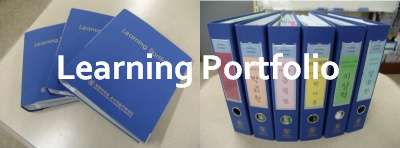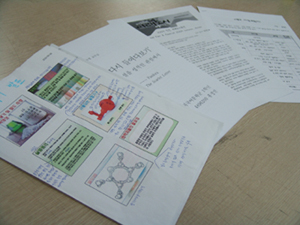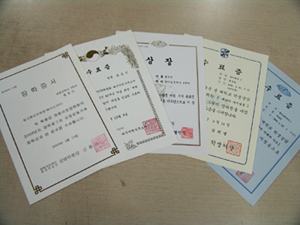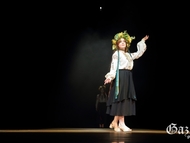
Nowadays, university students’ interest in learning portfolios is growing. A learning portfolio is a compilation of a students’ own personal information and background or plans of study. If students organize their learning portfolios well, they can prove their abilities and experiences effectively when they want to enter a graduate school or a company. Keimyung Center for Teaching & Learning has been supporting three hundred students in developing learning portfolios. It provides some tips on how to make a learning portfolio by giving special lectures and offering binders to students. In this issue, the Gazette introduces learning portfolios and how to make them.
Making a Learning Portfolio
①Set goals - The purpose of making a learning portfolio has to be concrete, like improving studying ability, developing studying strategies, and so on.
②Make learning portfolios – In learning portfolios, there are five parts. Personal information, learning activities, extracurricular activities, self-reflection activities, and other activities are the parts.
③ Self-reflection activities – Reflect on, analyze, and evaluate students’ studying and learning.
④Put the materials in a binder - Make a table of contents and organize the resources systematically.
Process of Developing a Learning Portfolio
①Planning→②Selecting→③Reflecting→④Revising & Reviewing→⑤Compiling

Part 1. Personal Information
Personal Information: name, photo, e-mail address, homepage or blog address
Letter of Self-introduction: background, vision, hobbies and interests, strengths and weaknesses
Experience: academic background, job experience, certificates, overseas experience
Other Activities: diplomas, certificate of grade in university, certificates like TOEIC or MOS, etc.
Personal Information includes resume, letter of self-introduction, and qualifications. You can also include your TOEIC or MOS certificates.

Part 2. Learning Activities
Learning philosophy: one’s own philosophy about learning
Learning goals: short-term and long-term learning goals
Learning planning: specific study plan including year, major, and subject
Learning activities: study group, peer tutoring, etc.
Learning outcome: reports, presentations, thesis, etc.
Learning evaluation: feedback by professors, evaluation by peers, etc.
Learning activities include your overall study activities. The following is how to organize learning activities. First, write down your philosophy about learning and short-term and long-term plans. Based on your philosophy about learning, write down your study habits and then set up specific plans. Write your study plan according to the semester, year, major, and subject. If you make your plan according to your goal of learning and learning method, it is helpful to make a clear study plan. Add information about study groups or peer tutoring. After you organize your study plans and materials, add evaluations by your professors or peers and reports and any other outcomes of your study.
Part 3. Extracurricular Activities
Club activities: evidence of club activities
Volunteer work: proof of volunteer work
Studying abroad and internships: materials related to studying abroad or internships
Research and development activities: materials related to projects or seminars
Contest participation: contest materials
Extracurricular activities follow your learning activities. Typically, there are club activities and student union activity. You need to write down your role and your activity in the club or student union. When you organize volunteer work, it is good to write the name of the organization, the period of time you worked, and details about your work. You should attach evidence such as certificates and pictures. In addition, if you ran a project or held a seminar, you can attach the name of the project or the seminar, your role, and the date of the seminar with the seminar materials or a pamphlet. Also you can verify activities related to contest participation with pictures, or if you won a prize at contests or other activities, you can attach certificates of award.
Part 4. Self-reflection Activities
Inspection of learning goals: reflection on your learning goals
Inspection of the learning process: reflection on your learning method and study activities
Inspection of the result of learning: reflection on result and evaluation of learning
After organizing the learning activities and extracurricular activities, you should reflect on yourself. Look back over the past to consider whether you achieved your learning goals and think about the good points and bad points during the activity period. Also think about whether you obtained satisfying results or not. Then, describe your reflection on yourself in about two or three pages. If you evaluate your activities according to semester, year, major, and subject, you can evaluate yourself more specifically.

Part 5. Other Activities
Other materials and outcomes showing your activities
It is the time to show any other activities during your student days. There are many awards and scholarships. Arrange awards according to name, date, and type, and arrange scholarships according to the name of the scholarships, date, and the amount of scholarship money. Verify campus activities such as Keimyung Study Supporters or Keimyung Peer Tutoring with certificates and pictures. Then, add copies of certificates such as computer certificates, Chinese character certificate, food certification, certificates of martial arts, and driver’s license.
Put all of your materials in a binder in order. Your learning portfolio helps you understand yourself from your personal information, study materials, extracurricular activities, and self-reflection, and you can find your activities easily by organizing all your information in one binder. When you go to a company, it is also helpful to show this portfolio. A learning portfolio helps your student life and your future life, too.
hjm410@kmu.ac.kr
aeiou01@kmu.ac.kr
aeiou01@kmu.ac.kr








